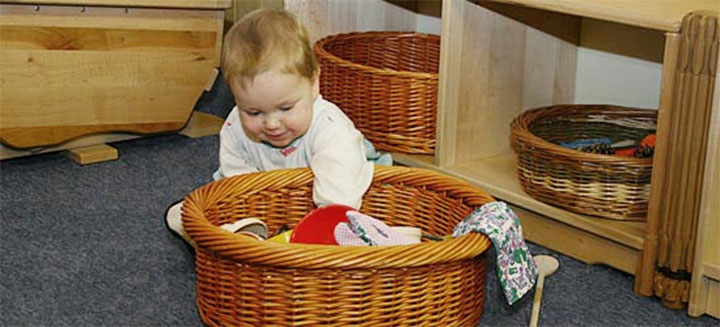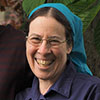Treasure baskets
| June 2012How do babies learn and play?
Anyone who cares for babies knows they learn by actively doing, engaging life with all their senses and limbs. As well as providing space for them to develop their motor abilities, we need to nurture their curiosity. The Treasure Basket was conceived with this in mind, providing objects of various sensory qualities for babies to investigate. In the process of enjoying the activity, babies learn about their world. Tom Shea points out that ‘Frequent users of the Treasure Basket have been observed sifting through and discarding all the items until they find their favourite object, proof of the vital connections taking place in the brain.’
When babies learn to sit, they view the world from a new perspective, observing much that was previously invisible to them. This is exciting but can also be frustrating, as an infant notices objects and activities that are out of reach. This is the stage when the Treasure Basket is so helpful, providing scope for exploration in spite of the child’s lack of mobility.
What are treasure baskets?
The Treasure Basket is made of sturdy wicker, strong enough for a sitting baby to lean an elbow on without flipping the basket. It is approximately fourteen inches across and four or five inches deep. It has straight sides, and is filled with objects of varying tactile qualities for babies to enjoy.
The Treasure Basket concept was inspired by Elinor Goldschmied many years ago, but has caught on throughout the United Kingdom and increasingly in other countries as well. It is a simple yet profound idea, opposing the trend to give commercial plastic toys to babies by providing them instead with a richer sensory experience.
Why should plastic be avoided for babies? It offers very little sensory stimulation; even if plastic items vary in size and colour, they still smell, taste, and feel like plastic. Natural objects on the contrary possess a wide variety of sensory properties, and many therefore are perfect for the Treasure Basket. As a baby notices a seashell or lemon, then picks it up to explore with gums and tongue, she simultaneously catches its texture, colour, scent and flavour. Many everyday household articles also afford a variety of sensory experience and can be popped into the Treasure Basket as well. As a baby shakes or bangs a whisk or a bunch of keys, he notices the sounds he has produced as well as the sensations in his arm and hand. Such actions strengthen cognitive development and motor control.
Picking the best items for your treasure basket
You will enjoy choosing items of varying tactile qualities to incorporate in your Treasure Basket – a dried gourd, large feather, whisk, measuring spoons, rubber tube, bottle brush, fir cone, lemons and limes, sponge, leather glove, seashell, bunch of keys, piece of fleece, nail brush, wool pom-poms, wooden spoon… – for babies to scrutinise, squeeze, rub, bang, shake, mouth, drop, and pick up at will. You’ll need to regularly check for safety and cleanliness of objects, as well as replenishing the Basket to maintain the babies’ interest.
While babies enjoy the Treasure Basket, the carer or parent sits nearby, quietly observing and enjoying the action but not interfering unless necessary. Babies need opportunities to make their own discoveries, and adult talk poses a distraction to their concentration. Your quiet presence will give the children security, and they can always look up to make eye contact or exchange a smile if they wish. They will let you know with body language and other signals when they have had enough, at which point you can put the Treasure Basket away for another day.







